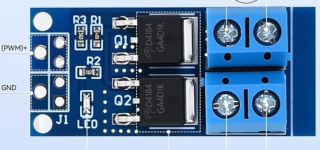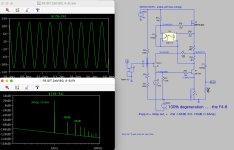I have seen a schema of optically coupled MOSFET ciruits, as a solid state reay. I saw that Renesas has astory line about isolated mosfet drivers. Some vendors focus on 100kV switching. . . But we need automotive quality like Toshiba's TLP570xH IGBT & MOSFET Isolated Gate Driver.
 While this picture assumes the mosfets are inside the package,
While this picture assumes the mosfets are inside the package,
the following is a driver that needs external Mosfets: VOM1271.
 Just. Four pins!
Just. Four pins!
 Drive a single or back-to-back N-mosfets (sources combined).
Drive a single or back-to-back N-mosfets (sources combined).
"Unlike conventional MOSFET drivers, which require an external power supply to provide VCC and or VDD rails to the driver itself, the VOM1271 obtains all the required current [=voltage] to drive its internal circuitry from the LED current on the low voltage primary side of the isolation barrier." The cell generates the voltage to turn on the mosfet, up to 8.4V.
The essence is that the driver signal is totally isolated from a power line. useful for switching power lines. Or. For instance as speaker relay, as it can handle AC. They handle 40A both ways. With <5mOhm resistance, and "<-90dB distortion".
My interest is as follows: I want to have an amplifier with on the one hand an F4 (no gain, no pain) and also an F8 (my version of a SIT follower, no gain, lots of pain). [My F8 is a mash-up of for example ZM's BJT version; I choose the nice 2SJ74 as input, maybe should call it J2/F8 to make things more complex; See attached. 2.]. . . Essential: Same power lines as F4 (25V).
 but this board is not isolated. GND is common ground. But it probably is bidirectional, having two fets back to back. So that one extra component is needed.
but this board is not isolated. GND is common ground. But it probably is bidirectional, having two fets back to back. So that one extra component is needed.
An example of a driver that is isolated, is: VOM1271 (Vishay) = Photovoltaic MOSFET Driver With Integrated Fast Turn-Off, for Solid-State Relay. There must be more.
the following is a driver that needs external Mosfets: VOM1271.
"Unlike conventional MOSFET drivers, which require an external power supply to provide VCC and or VDD rails to the driver itself, the VOM1271 obtains all the required current [=voltage] to drive its internal circuitry from the LED current on the low voltage primary side of the isolation barrier." The cell generates the voltage to turn on the mosfet, up to 8.4V.
The essence is that the driver signal is totally isolated from a power line. useful for switching power lines. Or. For instance as speaker relay, as it can handle AC. They handle 40A both ways. With <5mOhm resistance, and "<-90dB distortion".
My interest is as follows: I want to have an amplifier with on the one hand an F4 (no gain, no pain) and also an F8 (my version of a SIT follower, no gain, lots of pain). [My F8 is a mash-up of for example ZM's BJT version; I choose the nice 2SJ74 as input, maybe should call it J2/F8 to make things more complex; See attached. 2.]. . . Essential: Same power lines as F4 (25V).
- I envision to be able switch between the two, by swithing the V+ and V1 alternately, and I do not trust a relay DT enough for that. And then also switch the output.
- + Luxury option: on DC, disable the output. . .
 but this board is not isolated. GND is common ground. But it probably is bidirectional, having two fets back to back. So that one extra component is needed.
but this board is not isolated. GND is common ground. But it probably is bidirectional, having two fets back to back. So that one extra component is needed. An example of a driver that is isolated, is: VOM1271 (Vishay) = Photovoltaic MOSFET Driver With Integrated Fast Turn-Off, for Solid-State Relay. There must be more.
- Any experiences with this use-case?
- Suggestions?
- Experiences?
Attachments
Well, today's search helped me a lot.
Other drivers are FDA117 - a photovoltaic MOSFET driver comprisingan LED that is optically coupled to a photodiode array.
By the way, OCMOS is a patented name from renesas 😕
+ I found an almost complete board, not yet totally to my liking (it is single switching direction, not bidirectional such that it is useful for AC/speaker or as a relay on the negative rail but more on that); the optocoupler is a Sharp PC817 as far as I can read the picture. Other offers exist! See a 10-pack.

One can now bricolage a back-to-back second lr7843 mosfet (connecting the sources and gates together, the drains being ad-hoc/simultaneous in and output so it handles AC and negative rail . . .
--
The PC817 opto is also used in a mechanical relay, as Andrea Cuffioli proposes in his Circlotron Guide:
There are also speaker protection boards where a specialized chip is used; that has my interest too as it contains a specific logic.
Other drivers are FDA117 - a photovoltaic MOSFET driver comprisingan LED that is optically coupled to a photodiode array.
By the way, OCMOS is a patented name from renesas 😕
+ I found an almost complete board, not yet totally to my liking (it is single switching direction, not bidirectional such that it is useful for AC/speaker or as a relay on the negative rail but more on that); the optocoupler is a Sharp PC817 as far as I can read the picture. Other offers exist! See a 10-pack.

One can now bricolage a back-to-back second lr7843 mosfet (connecting the sources and gates together, the drains being ad-hoc/simultaneous in and output so it handles AC and negative rail . . .
--
The PC817 opto is also used in a mechanical relay, as Andrea Cuffioli proposes in his Circlotron Guide:
- the delay in connecting the speakers to the amplifier is some 2 seconds. A three ch. mech one exists too."I use 2 x AIYIMA 2.0 Digital Power Amplifier Speaker Protection Board Delay Relay Speaker Protection available on Alixpress online shop. This module use 2 optoisolator PC817 for each input and are necessary only some little changes to increase the start-up time."
There are also speaker protection boards where a specialized chip is used; that has my interest too as it contains a specific logic.
